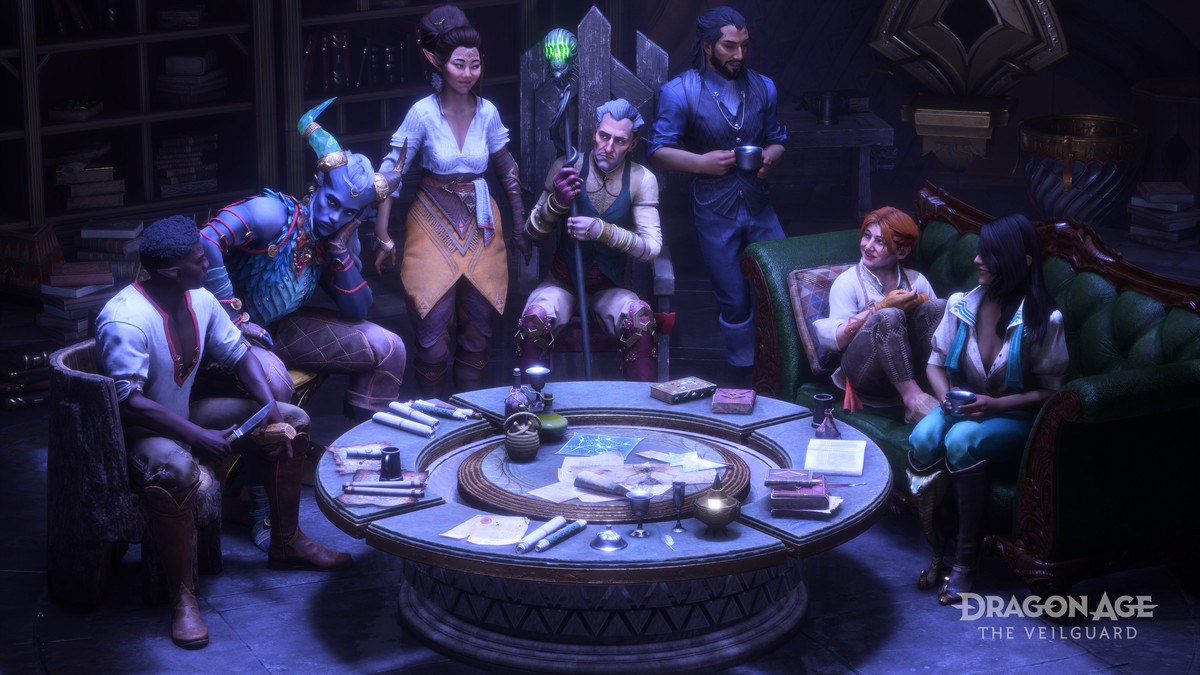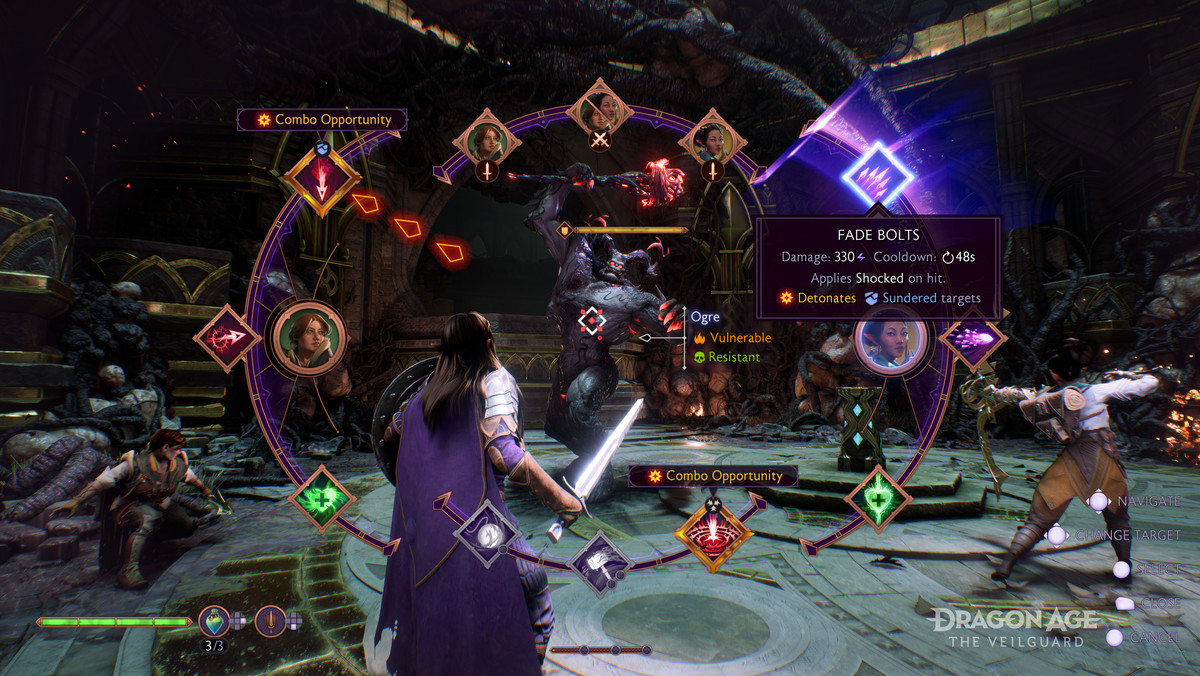It’s tough to be a Dragon Age fan in 2024. It’s been 10 years since Dragon Age: Inquisition, and BioWare has changed a lot since then, having made a very different type of game in Anthem that had fans (and former staffers) fretting that studio had turned away from its focus on narrative-centric games. That might be why, when I saw the first hour of Dragon Age: The Veilguard in a hands-off demonstration at Summer Game Fest, the game’s creative director John Epler said the word “narrative” to me at least a dozen times, as though trying to reassure me this game would not let me down on that score. I ate it up every time, grinning and nodding like a bobblehead. Because, honestly? That’s all I really want Dragon Age: The Veilguard to be, and I don’t think I’m alone.
The first hour of the game drops your player character right in the midst a real bad situation. As we know from Inquisition, Solas has decided it’s time to destroy the Veil, a construct that he himself created long ago that separates the physical realm of Thedas from the magical, metaphysical realm called the Fade. Way back in the day, these two worlds weren’t separated, but Solas separated them because he thought it would be helpful to his fellow elves, and it kinda was, except it also caused a lot of other problems.
Unfortunately, destroying the Veil will also cause a lot of problems, like ghostly spirits and demonic entities coursing out of the Fade and attacking the innocent citizens of Thedas. That massive, sparkly battle is how the game begins, with your character (a newcomer of your own customization) getting thrown in with Dragon Age stalwarts like Varric and secondary character Harding, who has been promoted to party member status in The Veilguard.

Character customization is very extensive here; you can choose from the four races (human, elf, Qunari, or dwarf) and then choose a fighting class (rogue, mage, or warrior). You then choose from several backstories that inform what type of person you were before you showed up in the midst of the high-octane action sequence at the start of the game. The character creator has lots of sliders for body parts and overall shape, none of which are tied to the voice or pronouns (she/her, he/him, or they/them, a new addition to the series) that you choose. Thankfully, you can look at your character in different lighting upon designing them to be sure you’ll actually like their custom appearance. Epler took special care to show off the extensive curly and textured hair options in the game, including several versions of braids and locs, noting that increasing these options in particular was very important to the team. You can change your character’s physical appearance at any time during the game, but not their class or backstory.
After designing a rogue character, we caught up with Varric and pals. I was so excited to see Varric and hear him telling jokes; he’s my favorite character. This was around when I asked Epler about dating-sim mechanics in the game, to which he simply laughed and refused to answer in specifics. (BioWare general manager Gary McKay told IGN earlier this month that players can “romance the companions [they] want,” which has led most people to assume that this Dragon Age is different from Inquisition, in which all the companions had specific sexual orientations.) Epler did assure me that the player character’s choices will increase or decrease the other characters’ estimation of them over the course of the game.
From what I saw, the combat in the game looks exciting and engaging, although it may disappoint those who were hoping to have full control of every companion. You control your own character in real-time, third-person action combat — light and heavy attacks, parries, and dodges. You can also “pause” everything by pulling up an ability wheel to select further combat abilities, including combo attacks with your companions. Epler emphasized that the different combat classes should make it possible for every player to have a way to enjoy combat according to how they prefer to engage with it. Each individual class has some variability, too; even the mage class has some up-close-and-personal attacks, since a mage player character could still conceivably have an assassin backstory and would therefore need to have some attacks to accommodate that sort of career path.
For the people who don’t care so much about the combat and who will only be interested in those longed-for narrative elements, Epler also told me the game does have an easy mode, and that there is even a setting which makes it impossible for your player character to die in battle.

The Veilguard starts right in the middle of the action. Solas is already in the midst of his ritual to destroy the Veil, and you and your brand-new friends are going to do your best to stop him before he completes it. The city of Minrathous — which looks gorgeous, by the way, with neon magic illuminating shops and houses rather than electricity — has already been overrun with demonic entities and spirits that are attacking the populace. You and your pals fight your way through these baddies; eventually you run into Neve Gallus, a private investigator with impeccable fashion sense (she’s from the Dragon Age comics and also appears in a Dragon Age short story anthology, Epler told me). She joins up with you, Varric, and Harding, and you all keep fighting your way to Solas himself.
[embedded content]
Epler explained to me that the team wanted this opening hour to feel almost like the climactic ending of a different game. It definitely does — it’s sure not the slow start that some other Dragon Age games have had (I’m referring here to the Hinterlands in Inquisition). When you and your party finally reach Solas, Varric decides to try to talk him down rather than charge in with violence. I loved this section; as the rest of the crew was fighting off spirits, we could occasionally overhear bits of Varric and Solas’ tense, emotional conversation. Naturally, it’s not that easy to talk Solas out of his plan. The confrontation does result in his ritual being interrupted, but it definitely doesn’t seem like we’ve changed Solas’ mind.
After we wrapped up the hour of play, Epler turned to me to emphasize, once again, the game’s narrative. The game, he said, is really about each of the companions, each of whom will have their own storylines and arcs. I saw a lot of combat sequences in that first hour, but I also heard a lot of snappy dialogue. I left excited and even optimistic about getting to know my new group of pals. After all, it’s Dragon Age — and it’s about narrative, people! That’s what they told me, and so that’s what I’m going to keep on being excited about playing when Dragon Age: The Veilguard is finally released. For now, the release date is fall 2024 (although that’s all we’ve got, still no exact date), and it’s coming to PlayStation 5, Windows PC, and Xbox Series X.